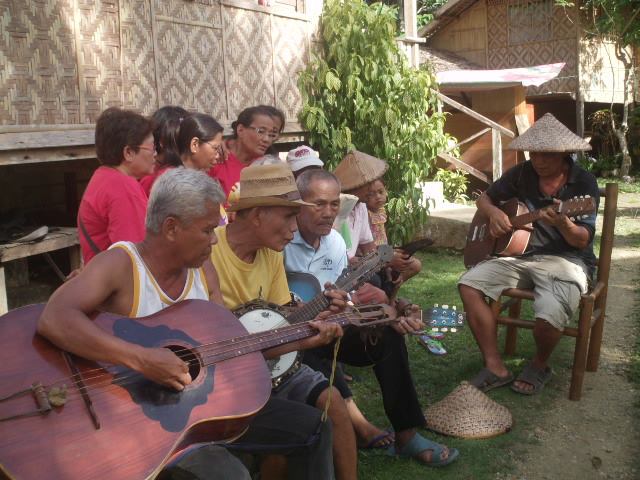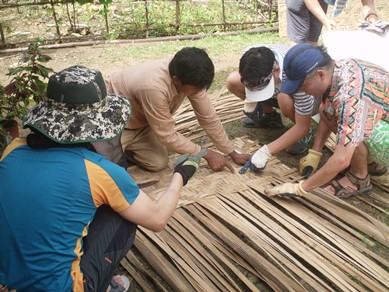Maribojoc, Bohol. Carolers of varied ages sing pleas at the foot of an ancestral house to allow a weary couple, the wife pregnant, to come in and rest after a long travel, while a middle-aged man goes up and down the wooden stairs and tells the couple in a loud voice to go away since the “inn” is full. He threatens to call the dog if they do not leave.
The hyper dramatic antics of the “tagbalay nga palaran” (the wealthy house-owner) usually make kids shriek in a mixture of fear and delight, while adult viewers express empathy for the costumed Holy Couple driven away (“gi-igihan”) to fend for themselves. They sometimes even join in the singing.
Just a few years back, such scenes could still be seen as part of the “Igue-Igue Daygon sa Pagkatawo“ or folk Christmas musical theater tradition on the island province. But they have now become rare, laments Fructuosa Hibaya, 80, a bearer of the Christmas musical tradition in Toril, Maribojoc.

Practising Daygon sa Pagkatawo in Toril, Maribojoc. (Photo by Cooper Resabal)
The community theater musical tradition, passed on during the era of colonization, had been used as a teaching medium for a peasant population, but it also included elements indicating an “indigenizing and contextualizing of the imposed Western belief system,” researches show.
The daygon (praise) tradition incorporates movements, like the dancing pastores (shepherds) and the sore homeowners, and lively tunes that make the otherwise drab singing of biblical stories and church doctrines more theatrical, attention-getting and entertaining.
While these songs were brought in during the Western colonization, no wholesale importation of tradition took place here. “Coming from the native peasantry, the daygons reflect an insistence at localizing the faith they received from a foreign source,” said Marianito Luspo, Bohol cultural researcher. This, in his view, “makes the daygon a valid expression of Filipino culture.”
“It was on that hill overlooking the lawn and house of then local prominent leader Gervacio Resabal that the folks in the community watched the ‘igue-igue’ (driven away) being presented with the homeowners joining and taking the singing roles of the wealthy residents driving the couple away,” Hibaya recalled with nostalgia.
Mansueta Borcelas, another cultural bearer in Maribojoc, said her mother Estanislawa Aguhob Borcelas taught her and the whole family the “Daygon sa Pagkatawo” (Praise for the Birth). She recalled that her mother, who wrote and directed plays, would gather the young folks before Christmas. They would sing the ‘igue-igue’ and later perform with the rondalla complete with props.
The folk carol tradition is considered an endangered folk Christmas community theater act now and is rarely practiced in the towns of Maribojoc, Antequera and Baclayon.

Daygon sa Pagkatawo revival in Tagbilaran. (Photo by Center for Culture and Arts Development)
In the past, the “Daygon sa Igue-Igue” was sang from Dec. 16-23, then from Dec. 24- 27, there was the “Daygon sa Pagkatawo,” followed by the “Daygon sa Tulo Ka Hari” (Carol of the Three Kings) from Dec. 28 up to Jan. 6.
Aside from the lack of interest among the younger generation, the traditional Christmas Daygon of Bohol faces challenges from modern Western music and other influences. Professor Luspo of Holy Name University pointed out that influences from jazz and other Western musical genres have led to the loss of original details and many essential qualities from the tradition.
Simi Guilen, another bearer of the tradition, disclosed that a group is attempting to revive the unique Christmas tradition here, but she is not sure if enough participants could be gathered. “Very few people know the songs, and the young are not interested and too busy with their cellphones,” she said in the local dialect.
Luspo observed that Bohol’s Christmas daygon has already lost its original meaning. In the past, residents of Maribojoc, Baclayon and Antequera performed the tradition with the sole motive of giving praise to the infant Jesus. Now, the few living practitioners are primarily motivated by cash considerations and perform the tradition in exchange for some amount from homeowners.
The hour-long Christmas musical was an instructional tool for people to know the story of the nativity, including some of the doctrines of the Roman Catholic regarding the nature of the birth of Christ. It describes how Christ was born: “Nag-antus sa mga kapobre, gipahigda sa presepre. Ang banig habol gisilbi ang uhot, ug ang dagami.” (In poverty, he was made to lie in a box, with hay as bed and blanket).
The community theater musical tradition brings the key message of salvation: “Ang pulong sa anghel sabton ta, kay ang dakong kalipay midangat na, kay natawo tungod kanimo ang manluluwas nga Ginoo. (Listen to the angels’ message that brings great joy since the Savior is born).”
Researchers explained that the original daygon was intended as a devotional practice, allowing ordinary folks to express joy over an important event through singing and dancing.
The house-to-house caroling was aimed primarily at making repeated adorations to the Christ Child, a form of prayer, Luspo underscored. This means it was never done with the intention of soliciting goods from householders. “If the homeowner, grateful for the visit, offered refreshments or token money, it was not the manaygonays’ (carolers’) intention,” he said.

Rondalla for the Daygon sa Pasko revival in Tagbilaran. (Photo by Center for Culture and Arts Development)




